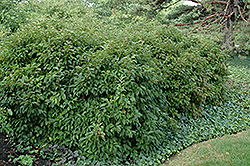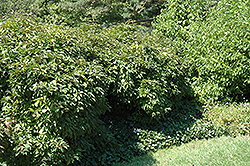It's all about ...
plants

Dwarf Fragrant Viburnum
Viburnum farreri 'Nanum'
Height: 3 feet
Spread: 5 feet
Sunlight:
![]()
![]()
Hardiness Zone: 5a
Description:
A dense and very compact shrub covered in clusters of sweetly fragrant flowers in very early spring followed by berries that fade from red to black over the summer, attractive to birds, good fall color; a perfect size for the garden, great in groupings
Ornamental Features
Dwarf Fragrant Viburnum features showy clusters of fragrant white flowers with pink overtones at the ends of the branches in early spring, which emerge from distinctive cherry red flower buds before the leaves. It has dark green deciduous foliage which emerges deep purple in spring. The serrated pointy leaves turn an outstanding burgundy in the fall. The black fruits are held in clusters from mid summer to early fall.
Landscape Attributes
Dwarf Fragrant Viburnum is a dense multi-stemmed deciduous shrub with a mounded form. Its average texture blends into the landscape, but can be balanced by one or two finer or coarser trees or shrubs for an effective composition.
This is a relatively low maintenance shrub, and should only be pruned after flowering to avoid removing any of the current season's flowers. It is a good choice for attracting birds to your yard, but is not particularly attractive to deer who tend to leave it alone in favor of tastier treats. It has no significant negative characteristics.
Dwarf Fragrant Viburnum is recommended for the following landscape applications;
- Mass Planting
- Hedges/Screening
- General Garden Use
Planting & Growing
Dwarf Fragrant Viburnum will grow to be about 3 feet tall at maturity, with a spread of 5 feet. It tends to fill out right to the ground and therefore doesn't necessarily require facer plants in front. It grows at a slow rate, and under ideal conditions can be expected to live for approximately 30 years. While it is considered to be somewhat self-pollinating, it tends to set heavier quantities of fruit with a different variety of the same species growing nearby.
This shrub does best in full sun to partial shade. It prefers to grow in average to moist conditions, and shouldn't be allowed to dry out. It is not particular as to soil type or pH. It is somewhat tolerant of urban pollution. This is a selected variety of a species not originally from North America.
This plant is not reliably hardy in our region, and certain restrictions may apply; contact the store for more information.

